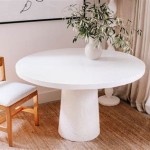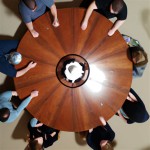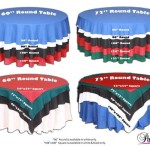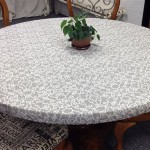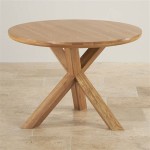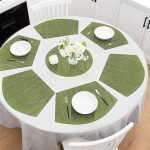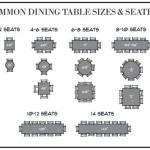How To Make A Large Tablecloth Fit A Smaller Table Size
Often, individuals possess a tablecloth that is larger than their current table, perhaps inherited, purchased for a larger table previously owned, or acquired on sale without precise measurement. Rather than relegating the tablecloth to storage, several methods exist to effectively adapt it to a smaller table size. This article provides a comprehensive guide to achieving a well-fitted tablecloth appearance, outlining various techniques from simple adjustments to more involved alterations.
Understanding the Options: From Temporary Fixes to Permanent Alterations
The approach to fitting a large tablecloth onto a smaller table depends largely on the desired aesthetic and the commitment level one is willing to invest. Temporary solutions offer quick fixes suitable for occasional use or when a non-permanent solution is preferred. These methods are ideal for preserving the integrity of a cherished or valuable tablecloth. Permanent alterations, conversely, provide a more tailored and refined appearance, best suited for tablecloths that will be used frequently on the smaller table and where permanently altering the original size is acceptable.
The fabric of the tablecloth also plays a crucial role in determining the best course of action. Delicate fabrics may necessitate gentler handling and less invasive techniques, while more robust materials can withstand more rigorous manipulation. Consider the fabric composition, weave, and any embellishments before proceeding with any adaptation method.
Temporary Adjustment Techniques
These methods offer reversible solutions for situations where a temporary fix is sufficient or where altering the tablecloth permanently is undesirable.
1. The Tuck-and-Pin Method: This simple technique involves tucking excess fabric underneath the tablecloth until the desired drop is achieved. Secure the tucks with safety pins or tablecloth clips to prevent them from unraveling. The pins should be placed discreetly underneath the edge of the table to minimize visibility. This method is best suited for tablecloths with minimal excess fabric and for tables with a lip or overhang where the tucked fabric can be concealed. While straightforward, it may not be suitable for formal occasions as the tucked fabric can sometimes look uneven.
2. Overlapping Tablescapes: Strategic placement of placemats, runners, or other decorative elements can effectively conceal excess fabric. By overlapping these items over the edges of the tablecloth, one can create the illusion of a better fit. This method is particularly effective for rectangular tables where extra fabric can be masked along the longer sides. Choosing visually interesting and textured placemats and runners can draw attention away from the potential imperfections of the tablecloth adjustment.
3. Tablecloth Clips: Tablecloth clips are commercially available in various styles and materials. These clips attach to the edge of the table and the tablecloth, effectively pulling the fabric taut and preventing it from drooping excessively. They are particularly useful for outdoor settings where wind can cause the tablecloth to billow. While functional, the aesthetic appeal of tablecloth clips can vary; choose clips that complement the overall table setting.
4. Elastic Bands or Fabric Ties: Similar to the tuck-and-pin method, this technique involves gathering excess fabric underneath the table and securing it with elastic bands or fabric ties. This provides a more secure hold compared to safety pins, particularly for heavier fabrics. However, this method may still be visible if the table lacks a significant overhang to conceal the gathered fabric.
5. Using a Smaller Underlay: A smaller tablecloth, sheet, or piece of fabric can be placed underneath the larger tablecloth to act as a filler, creating a more even surface and minimizing the appearance of excess draping. This is especially helpful for tables with uneven surfaces, as it helps to create a smoother base. The underlay should be a neutral color to avoid conflicting with the top tablecloth.
Permanent Alteration Techniques
These methods involve permanently altering the size of the tablecloth to create a custom fit for the smaller table. While more involved, they offer a more polished and refined appearance.
1. Basic Hemming: This is the most common and straightforward method for resizing a tablecloth. It involves measuring the excess fabric, cutting it off, and then creating a new hem along the edge. Precise measurement is crucial to ensure a uniform drop on all sides of the table. Seam rippers can be used to carefully remove the existing hem, providing a clean edge for the new hem. Several hemming techniques exist, including a simple single-fold hem, a double-fold hem for added durability, and a blind hem for a nearly invisible finish. Sewing machine is recommended for this task, and should use a suitable thread color that matches the tablecloth fabric and consider using a walking foot to avoid slippage for larger and heavier tablecloth.
2. Adding Borders or Trim: Instead of simply hemming the excess fabric, one can add a decorative border or trim to the edge of the tablecloth. This provides an opportunity to personalize the tablecloth and add visual interest. The border can be made from a contrasting fabric, lace, ribbon, or other embellishments. Ensure the chosen border complements the tablecloth's existing design and color scheme. This method can also be used to subtly adjust the size of the tablecloth while adding a decorative element.
3. Creating Corner Pleats or Darts: For circular or oval tablecloths, simply hemming the edges can result in an uneven or puckered appearance. Creating corner pleats or darts can help to distribute the excess fabric evenly and create a smoother, more tailored fit. Pleats involve folding the fabric into even sections and securing them with stitches, while darts involve sewing a tapered seam to remove excess fabric. This technique requires careful planning and precise execution to ensure a balanced and symmetrical result.
4. Transforming it into Multiple Smaller Tablecloths or Linens: If the tablecloth is significantly larger than the table, consider repurposing it into multiple smaller tablecloths, napkins, or placemats. This is a practical way to utilize the fabric and create a coordinated table setting. When cutting the fabric, consider the existing patterns or designs to create visually appealing pieces. This approach is particularly suitable for large, plain tablecloths or those with repeating patterns.
5. Professional Tailoring: For valuable or intricate tablecloths, consider enlisting the services of a professional tailor or seamstress. Professional tailors possess the expertise and equipment to handle delicate fabrics and complex alterations with precision. While more costly than DIY methods, professional tailoring ensures a flawless and long-lasting result. This is a worthwhile investment for tablecloths that hold sentimental value or that are made from expensive materials.
Key Considerations Before Proceeding
1. Fabric Type and Care Instructions: Before attempting any alteration, carefully examine the fabric of the tablecloth and review its care instructions. Some fabrics are more delicate than others and require gentle handling. Dry-clean-only fabrics should ideally be altered by a professional to avoid damaging them. Understanding the fabric composition will also inform the choice of thread, needle, and sewing techniques.
2. Measurement and Planning: Accurate measurements are crucial for achieving a well-fitted tablecloth. Measure the dimensions of the table precisely, and determine the desired drop (the amount of fabric that hangs over the edge of the table). Use these measurements to calculate the amount of fabric that needs to be removed or adjusted. Create a detailed plan outlining the steps involved in the alteration, including cutting lines, seam allowances, and hemming techniques. A well-thought-out plan will minimize errors and ensure a successful outcome.
3. Testing on a Scrap Fabric: Before working on the actual tablecloth, practice the chosen alteration technique on a scrap piece of similar fabric. This allows to refine skills, identify any potential problems, and adjust the technique as needed. Testing on a scrap fabric can save from making costly mistakes on the tablecloth itself.
By carefully considering these factors and selecting the appropriate adjustment technique, individuals can successfully adapt a large tablecloth to fit a smaller table, preserving its beauty and functionality.

60 Second Diy Fitted Rectangular Tablecloth Cv Linens

Fitted Table Cover The Easy Diy

Let S Talk Linens The Ultimate Guide To Table Linen Sizes Party Al Ltd Pink Hippo Blog

Fitted Table Cover The Easy Diy

Tablecloth Size Guide Table Linen Hire Tips Plato Catering

Let S Talk Linens The Ultimate Guide To Table Linen Sizes Party Al Ltd Pink Hippo Blog

Urby 90 X 132 Inch Polyester Rectangular Table Cloth For 8 Foot That Seats 10 Person Fits Large Folding Tables Picnic Dining

Tablecloth Size Chart

Tablecloth Size Chart Asap Linen

Use This Tablecloth Size Chart For Perfect Party Planning Lovetoknow
Related Posts

